Surbiton
Hospital
Ewell Road, Surbiton, Surrey KT6 6EZ
Medical
dates:
Medical
character:
General
After 50 years, the facilities
at Surbiton Cottage Hospital
in St James Road were deemed inadequate and the Hospital Committee
decided to
build a new hospital to serve as a war memorial to the local servicemen
who had died WW1.
An Appeal was launched and, following numerous fund-raising events and public subscriptions, enough money was raised to enable the project to go ahead. The Hill Manor estate on Ewell Road was purchased as the site of the new hospital.
On 7th October 1934 Lord Ashcombe, the Lord Lieutenant of Surrey, laid the foundation stone for the new hospital, which was to be built in the grounds of the Manor. The estimated cost of the new building was about £38,812.
The Surbiton Voluntary Hospital was officially opened by the Duchess of Gloucester (1901-2004) on 28th July 1936. It had cost £54,000 to build and equip.
The Hospital had 78 beds. The main H-shaped block contained the administrative offices, the wards, an operating theatre, an X-ray Department and a large Out-Patients Department. A maternity block with 11 beds was adjacent to the main building.
During WW2 the Hospital joined the Emergency Medical Service, under the control of St Thomas' Hospital.
After the war the main block was extended. In 1946 a Physiotherapy Department opened and, in 1947, a Nurses' Home was built.
In 1948 the Hospital joined the NHS under the control of the Kingston Group Hospital Management Committee, part of the South West Metropolitan Regional Hospital Board. It was renamed Surbiton General Hospital. In the same year, a new Out-Patients Department opened, funded by a Peace Memorial Fund established at the end of the war to enlarge the Hospital as a commemoration of peace.
In October 1954 the Hospital had 72 beds, half of which were allocated to 20 local GPs and half to the Hospital's consultant staff. The GPs paid £25 yearly per occupied bed, shared out amongst themselves. The single-storey wards were bright and cheerful and there was a well-kept garden. The Hospital was considered to be well-equipped and a well laid-out modern hospital. The post-war Out-Patients Department, however, was too small, having only a waiting room and one consulting room. The 54 nurses on the staff were housed in the Nurses' Home and in two old rented houses.
In 1954 the Maternity ward, which had been staffed by a consultant and the 20 local GPs, closed because of nursing shortages. The ward was converted into a children's ward, while maternity patients were referred to Kingston Hospital, where 11 beds in the large 99-bedded maternity unit there were made available to the Surbiton GPs.
In 1974, following a major reorganisation of the NHS, the Hospital came under the control of the Kingston and Richmond Area Health Authority, part of the South West Thames Regional Health Authority.
In 1976 the Hospital had 68 beds and, in 1978, 51 beds.
In 1982, after another reorganisation of the NHS, the Hospital came under the control of the Kingston and Esher District Health Authority.
In 1990 the Hospital had 50 beds - 45 for GP admissions and 5 for patients with chest diseases.
In 1994, after yet another NHS reorganisation, the Hospital was under the administration of the Kingston and District Community NHS Trust, which had its headquarters in Claremont, its former site in St James Road.
By 2004, following more changes in the NHS, the Hospital was under the control of the Kingston Primary Care Trust, but it faced closure. The buildings were run-down and badly in need of repair. The back-up generator needed replacing, and water was leaking through the roof and under the floorboards.
Despite a vociferous campaign to keep the Hospital open - a local newspaper collected a 7,000 strong petition - the Trust, facing a looming financial crisis, decided to close the wards rather than spend £300,000 on fixing the roof.
In November 2005 the remaining 44 beds were closed and the in-patients needing intermediate care were transferred to Tolworth Hospital, while those needing continuing care were sent to a local nursing home.
Some healthcare-related facilities for out-patients remained on the site until 2011, when the Hospital finally closed.
Present status (February 2012)
Planning permission to redevelop the site as a new health facility and a new primary school was granted in March 2011.
The front gates and The Lodge are to be restored, but the remaining buildings will be demolished, despite being built as a War Memorial to both world wars. It may be that the memorial plaques, including the one on the entrance pillar commemorating the Silver Jubilee of King George V and Queen Mary in 1935, will be displayed in the new Health Centre.
The primary school is due to open in September 2012 and the new Health Centre, housing 4 GP practices with diagnostic and other services, including urgent care, in early 2013.
An Appeal was launched and, following numerous fund-raising events and public subscriptions, enough money was raised to enable the project to go ahead. The Hill Manor estate on Ewell Road was purchased as the site of the new hospital.
On 7th October 1934 Lord Ashcombe, the Lord Lieutenant of Surrey, laid the foundation stone for the new hospital, which was to be built in the grounds of the Manor. The estimated cost of the new building was about £38,812.
The Surbiton Voluntary Hospital was officially opened by the Duchess of Gloucester (1901-2004) on 28th July 1936. It had cost £54,000 to build and equip.
The Hospital had 78 beds. The main H-shaped block contained the administrative offices, the wards, an operating theatre, an X-ray Department and a large Out-Patients Department. A maternity block with 11 beds was adjacent to the main building.
During WW2 the Hospital joined the Emergency Medical Service, under the control of St Thomas' Hospital.
After the war the main block was extended. In 1946 a Physiotherapy Department opened and, in 1947, a Nurses' Home was built.
In 1948 the Hospital joined the NHS under the control of the Kingston Group Hospital Management Committee, part of the South West Metropolitan Regional Hospital Board. It was renamed Surbiton General Hospital. In the same year, a new Out-Patients Department opened, funded by a Peace Memorial Fund established at the end of the war to enlarge the Hospital as a commemoration of peace.
In October 1954 the Hospital had 72 beds, half of which were allocated to 20 local GPs and half to the Hospital's consultant staff. The GPs paid £25 yearly per occupied bed, shared out amongst themselves. The single-storey wards were bright and cheerful and there was a well-kept garden. The Hospital was considered to be well-equipped and a well laid-out modern hospital. The post-war Out-Patients Department, however, was too small, having only a waiting room and one consulting room. The 54 nurses on the staff were housed in the Nurses' Home and in two old rented houses.
In 1954 the Maternity ward, which had been staffed by a consultant and the 20 local GPs, closed because of nursing shortages. The ward was converted into a children's ward, while maternity patients were referred to Kingston Hospital, where 11 beds in the large 99-bedded maternity unit there were made available to the Surbiton GPs.
In 1974, following a major reorganisation of the NHS, the Hospital came under the control of the Kingston and Richmond Area Health Authority, part of the South West Thames Regional Health Authority.
In 1976 the Hospital had 68 beds and, in 1978, 51 beds.
In 1982, after another reorganisation of the NHS, the Hospital came under the control of the Kingston and Esher District Health Authority.
In 1990 the Hospital had 50 beds - 45 for GP admissions and 5 for patients with chest diseases.
In 1994, after yet another NHS reorganisation, the Hospital was under the administration of the Kingston and District Community NHS Trust, which had its headquarters in Claremont, its former site in St James Road.
By 2004, following more changes in the NHS, the Hospital was under the control of the Kingston Primary Care Trust, but it faced closure. The buildings were run-down and badly in need of repair. The back-up generator needed replacing, and water was leaking through the roof and under the floorboards.
Despite a vociferous campaign to keep the Hospital open - a local newspaper collected a 7,000 strong petition - the Trust, facing a looming financial crisis, decided to close the wards rather than spend £300,000 on fixing the roof.
In November 2005 the remaining 44 beds were closed and the in-patients needing intermediate care were transferred to Tolworth Hospital, while those needing continuing care were sent to a local nursing home.
Some healthcare-related facilities for out-patients remained on the site until 2011, when the Hospital finally closed.
Present status (February 2012)
Planning permission to redevelop the site as a new health facility and a new primary school was granted in March 2011.
The front gates and The Lodge are to be restored, but the remaining buildings will be demolished, despite being built as a War Memorial to both world wars. It may be that the memorial plaques, including the one on the entrance pillar commemorating the Silver Jubilee of King George V and Queen Mary in 1935, will be displayed in the new Health Centre.
The primary school is due to open in September 2012 and the new Health Centre, housing 4 GP practices with diagnostic and other services, including urgent care, in early 2013.
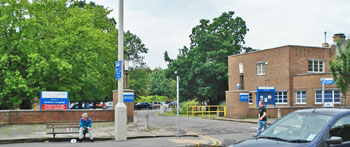
The entrance driveway from Ewell Road, with The Lodge on the right (above and below).
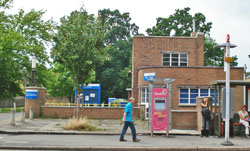

The Lodge bears the legend 'Surbiton Hospital'. It seems to have lost the work 'General' at some time, although it was still listed in the Medical Directories as Surbiton General Hospital.
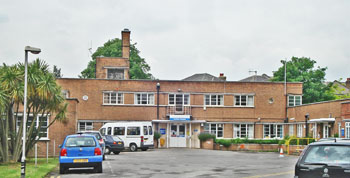
The main Hospital building containing the Out-Patients Department is flanked by single-storey wards.
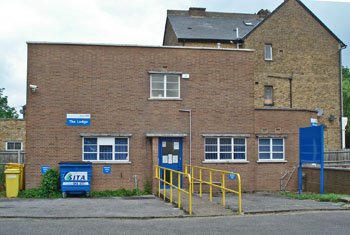
The gatehouse building - The Lodge - is to be preserved.
The photographs below were obtained in February 2012

The site is fenced off and the Hospital has been demolished.
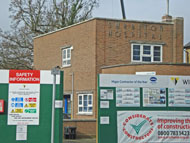
The Lodge remains, however.
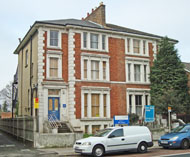
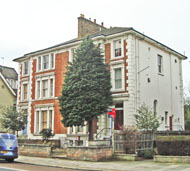
Elm House, 84 Ewell Road, once leased from the South West London and St George's Mental Health NHS Trust, is boarded-up and offered for sale. The building was once used by the Hospital for medical records and child health departments.
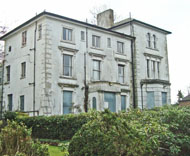
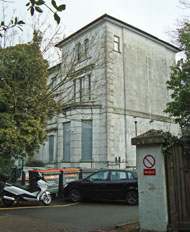
Newlands Nurses' Home in Oak Hill Road is also boarded up.


The current Oakhill Health Centre, built in the grounds of Newlands, is located beside the Newlands Nurses' Home in Oak Hill Road.

Computer-generated images of the new Health Centre on the Hospital site.
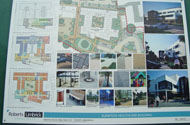
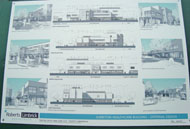
Details of the new Health Centre are posted on the fencing around the Hospital site.
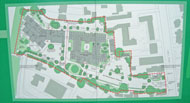
The final footprint of the Health Centre and Primary School on the site.
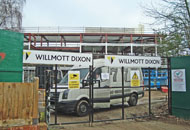
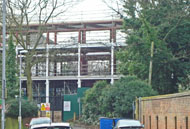
Building of the new school, on the west of the site, has already begun.
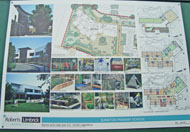
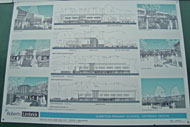
Details of the new Primary School.
Update: May 2013
(Photographs courtesy of Mike Chiu, Surbiton)
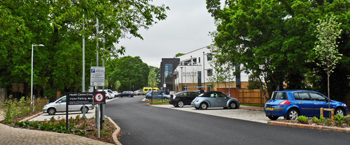
The entrance drive to the Surbiton Health Centre, which opened on 4th March 2013.

The Surbiton Health Centre was built at a cost of £9m. The bricks and foundations of the old Hospital were used to create the foundations of the new building.

The Health Centre (above and below) combines four GP surgeries from the area, and also offers services, such as breast screening, imaging, minor procedures and psychological therapy. The Urgent Care Unit has not yet opened.
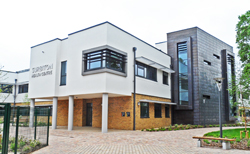
Update: September 2015
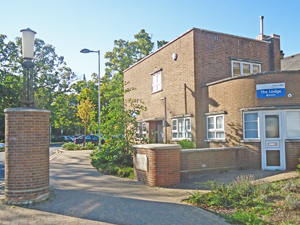
The original foundation stone, laid by Lord Ashcombe on 17th October 1934, is now mounted on the gate post (above and below).
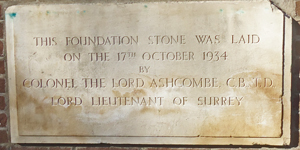
READERS' COMMENTS
"Such happy days were spent in the Newlands Nurses' Home and it was not far to travel to work at the Hospital!
Much of the silver used for Matron and the consultants was still around in 1965-1967 when I worked there - little salt and pepper pots, sugar bowls, etc. - used only by the illustrious.
These were the days when there was a prize for 'Nurse of the Year'. I didn't manage to win this, but did get the Tutor's prize (which was more highly valued for the academic contribution made by a nurse).
The Home Sister measured our bath water and, if it came to above the ankle, we were chastised. This would never these days - and yet they were such happy times."
"Such happy days were spent in the Newlands Nurses' Home and it was not far to travel to work at the Hospital!
Much of the silver used for Matron and the consultants was still around in 1965-1967 when I worked there - little salt and pepper pots, sugar bowls, etc. - used only by the illustrious.
These were the days when there was a prize for 'Nurse of the Year'. I didn't manage to win this, but did get the Tutor's prize (which was more highly valued for the academic contribution made by a nurse).
The Home Sister measured our bath water and, if it came to above the ankle, we were chastised. This would never these days - and yet they were such happy times."
Joan Mangnall,
February 2012
(Author unstated) 1934 The Hospital World. British Journal of Nursing (September), 248.
(Author unstated) 1936 The Hospital World. British Journal of Nursing (August), 217.
O'Sullivan JV 1961 General-practitioner maternity beds in a large general hospital. British Medical Journal 2 (18th Nov), 1349-1350.
http://ochp.org.uk
www.28dayslater.co.uk
www.brunswicksurgery.co.uk
www.derelictplaces.co.uk
www.flickr.com (1)
www.flickr.com (2)
www.ghost-of.org
www.images.british-towns.net
www.kingston.gov.uk
www.kingstonpct.nhs.uk (1)
www.kingstonpct.nhs.uk (2)
www.kingstonccg.nhs.uk
www.surbiton.com
www.surbitonpeople.co.uk
www.surreycomet.co.uk (1)
www.surreycomet.co.uk (2)
www.thisislocallondon.co.uk
Return to home page